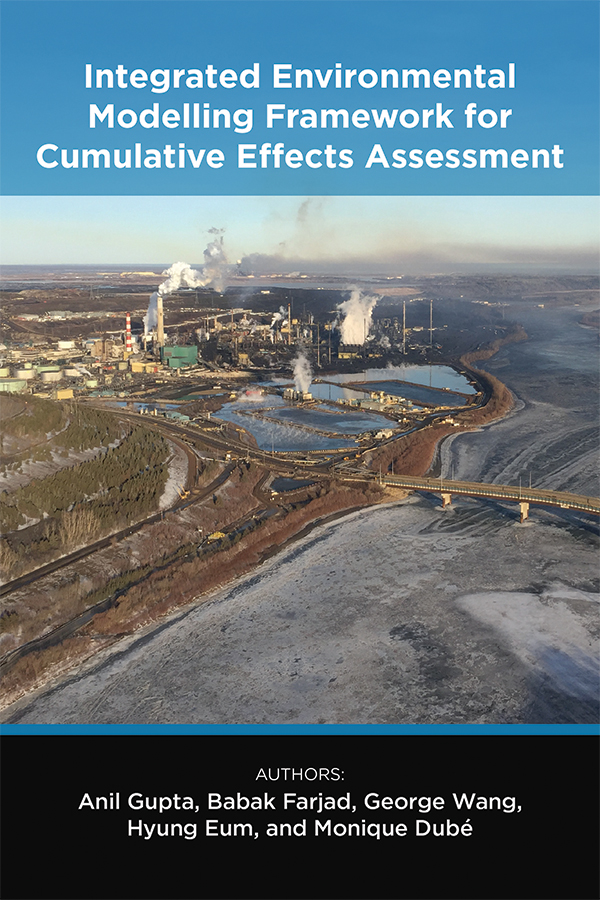
Integrated Environmental Modelling Framework for Cumulative Effects Assessment
Anil Gupta, Babak Farjad, George Wang, Hyung Eum, and Monique Dubé
$39.99 PB / $59.99 HC
212 pages, 23 illustrations
6 x 9 inches
Hardback: 978-1-77385-214-0
Paperback: 978-1-77385-198-3
Epub: 978-1-77385-201-0
January 2021
A thorough and detailed examination of integrated environmental modelling and integrated environmental modelling frameworks for cumulative effects assessment of complex environmental problems.
Global warming and population growth have resulted in an increase in the intensity of natural and anthropogenic stressors. Investigating the complex nature of environmental problems requires the integration of different environmental processes across major components of the environment, including water, climate, ecology, air, and land. Cumulative effects assessment (CEA) not only includes analyzing and modeling environmental changes, but also supports planning alternatives that promote environmental monitoring and management.
Disjointed and narrowly focused environmental management approaches have proved dissatisfactory. The adoption of integrated modelling approaches has sparked interests in the development of frameworks which may be used to investigate the processes of individual environmental component and the ways they interact with each other. Integrated modelling systems and frameworks are often the only way to take into account the important environmental processes and interactions, relevant spatial and temporal scales, and feedback mechanisms of complex systems for CEA.
This book examines the ways in which interactions and relationships between environmental components are understood, paying special attention to climate, land, water quantity and quality, and both anthropogenic and natural stressors. It reviews modelling approaches for each component and reviews existing integrated modelling systems for CEA. Finally, it proposes an integrated modelling framework and provides perspectives on future research avenues for cumulative effects assessment.
Published by LCR Publishing
Anil Gupta is a professional engineer with more than 25 years of experience in the field of environment and natural resources. He is a recognized expert in the field of integrated environmental modelling, climate change, big data analytics, geographical information system and geo-spatial analyses. He has been with Alberta’s public service for over 15 years and currently working as Director of Integrated Environmental Modelling and Predictions. Dr. Gupta is also an adjunct professor in the Department of Geomatics Engineering at University of Calgary.
Babak Farjad’s interests, education and work background have largely focused on hydrology, land, and climate modelling, integrated environmental modelling systems, and applications of machine learning and geomatics techniques in environmental modelling. He completed his PhD in Geomatics Engineering at the University of Calgary in 2015. Babak’s PhD investigated the responses of hydrological processes to climate and land-use change using an integrated modelling system.
George Wang is a water quality modeller at Alberta Environment and Parks. He is an environmental specialist with twenty years of research and consulting experience in surface water quality, water resources, and environmental management.
Hyung Eum is a surface water modeller with Alberta Environment and Parks, and currently works on statistical downscaling, climate change impacts, and hydrologic modelling. He has worked for Environment Canada and the Asia-Pacific Economic Cooperation Climate Centre.
Monique Dubé is an executive leader and environmental scientist with 28 years experience in research and education, multi-stakeholder negotiations, environmental monitoring, policy and regulation, technology innovation and cumulative effects assessment. She served as Executive Director led the Canada-Alberta Oil Sands Monitoring Program, was Chief Environmental Scientist of the Alberta Energy Regulator, and Canada Research Chair at the University of Saskatchewan. She sits on international scientific advisory panels and is recipient of numerous awards.
List of Figures
List of Tables
Acronyms and Abbreviations
1.0 Introduction
2.0 Interactions Between Environmental Components for Cumulative Effects Assessment
Climate and hydrology
Land, ecology, and climate
Land use/land cover (LULC) and hydrology
Air quality, climate change, water, and ecology
3.0 Modelling Approaches for Each Component
Hydrological models
Water quality models
Groundwater models
Land use/land cover models
climate models
Ecological models
Air quality models
4.0 Integrated Environmental Modelling
Integrated surface water-groundwater quantity modelling
Integrated watershed and receiving water quality modelling
Integrated watershed and groundwater quality modelling
Integrated groundwater and receiving water quality modelling
Integrated atmospheric deposition and water quality modelling
Integrated load allocation and water quality modelling
Integrated water allocation and water quality
5.0 Modelling in the Athabasca River Basin – Case Study
Hydrodynamic and water quality modelling in the Athabasca River
Atmospheric deposition and acidification modelling in the Athabasca Region
Watershed modelling in the Athabasca Region
Groundwater modelling in the Athabasca Region
Surface water and groundwater interactions in the Athabasca Region
Land use/land cover modelling in the Athabasca Region
Climate change in the Athabasca Region
Limitation of modelling for cumulative effects assessment in the Athabasca Region
Integrated Modelling Framework for CEA
Coupling strategy
Selection of models
Novelty of the proposed integrated environmental modelling framework
The challenges
7.0 Reference